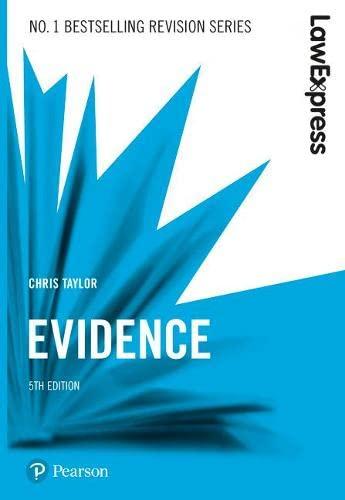Question
1.Which of the following is true with regard to employment law? a.The traditional test for determining whether or not a person is an employee is
1.Which of the following is true with regard to employment law?
a.The traditional test for determining whether or not a person is an employee is to assess the degree of control; an employee could be told not only what to do but also how to do it.
b.If a worker is injured on a job covered by the Workers Compensation Act, he can sue the employer for any injuries he may have suffered.
c.A lockout is action taken by employees to prevent the employer from operating as normal.
d.Constructive dismissal refers to a breach of the employment contract by the employer in which the employer has discovered that the employee committed theft.
e.Employees are allowed to strike only when the employer refuses to honour the collective agreement (a rights dispute).
2.Drew got a non-union, senior management job. After the first day, Drew went to his dad to discuss his obligations to his boss and his boss's obligations to him. Which of the following is false?
a.The employer owes Drew not only pay, but also some direction.
b.Drew must be punctual and obedient.
c.Drew owes the employer a fiduciary duty (i.e., a duty to serve the employer's interests above his own).
d.If Drew wants to quit, he must give the employer proper notice unless the employer has done some wrong (e.g., given an unreasonable or dangerous order).
e.The employer cannot terminate Drew's employment unless Drew does something wrong.
1.In many instances a person will be hired without any written employment agreement/contract. Even where a written employment agreement/contract is put in place, such a document may not provide when the employment will end. In such situations, which of the following is false?
a.In the absence of a specific provision as to when employment may end, upon termination an employer may simply impose the provisions in the Employment Standards Actstipulating what amounts to "reasonable notice" for such a termination.
b.If an employer wishes to terminate an employee in the absence of specific provisions as to termination and notice, in order to avoid responsibility for paying severance the employer can provide the employee with "reasonable working notice" in advance of the intended last day of employment.
c.If an employer wishes to terminate an employee in the absence of specific provisions as to termination and notice, the employer can offer a combination of working notice and severance pay that amounts to "reasonable working notice".
d.If an employee voluntarily retires from (gives up) their position of employment, no severance or working notice is required from the employer.
2.In many instances a business will face profound technological changes and will need to adapt or change the skill sets of their staff in order to survive in that changing business environment. Keeping in mind the contract principles having to do with changes to existing contractual engagements, which of the following is true in the employment realm?
a.Adapting to change ensures employee job security as the business will survive, as such employees are bound to accept changes to job responsibilities so long as the business provides time and resources to learn how to carry out the new job functions or processes;
b.Expecting employee agreement and providing time and resources to retraining is excessive and unreasonable in times when survival of the business is dependent on changing, Courts will not entertain claims of "constructive dismissal" from recalcitrant employees that will not agree to adapt to the changes necessary to survival.
c.Small incremental changes in a business environment are to be anticipated and requiring staff to train to adapt to such changes is not a contravention of an existing employment agreement/contract that would give rise to a complaint of constructive dismissal.
d.Continued employment in a fast changing and competitive business environment is sufficient contractual consideration for agreeing to a change in terms of employment.
1.As noted above, many employment agreements (written or verbal) do not address when the employment will end. Given that in situations where a person carries out their employment duties competently, those employment relationships last for months and years, which of the following is true?
a.The Employment Standards Actprovides that any written employment agreement must provide for a minimum employment period of six (6) months.
b.If a person is providing a service to a business for seven (7) days or less, that relationship cannot be a relationship of employment, i.e. the person is deemed to be an independent contractor.
c.Building contractors must be very careful in estimating the expected duration of their projects as any employees retained for such a project must have a definite "end date" for their employment as it cannot be stipulated to end simply once the project is completed.
d.If an employer has overlooked stipulating an "end date" into an employment agreement, they can "insert" such a provision after the fact so long as the employee agrees.
e.An employee who has carried out their duties competently for years may be terminated upon proper working notice being provided.
Step by Step Solution
There are 3 Steps involved in it
Step: 1

Get Instant Access to Expert-Tailored Solutions
See step-by-step solutions with expert insights and AI powered tools for academic success
Step: 2

Step: 3

Ace Your Homework with AI
Get the answers you need in no time with our AI-driven, step-by-step assistance
Get Started


